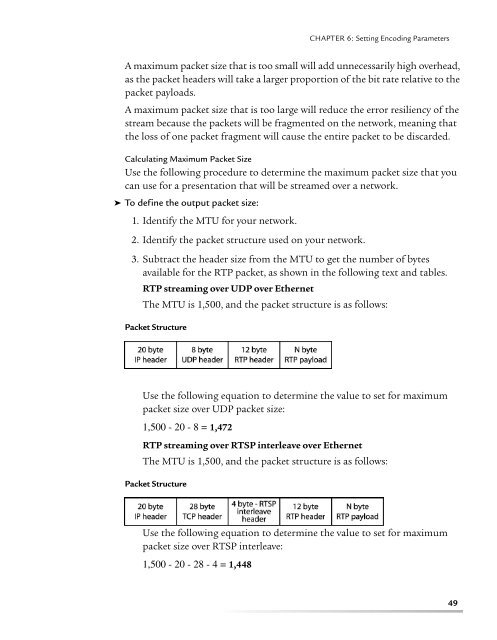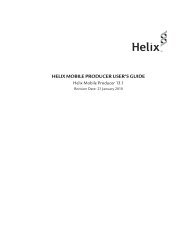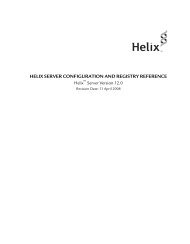helix mobile producer on-demand user's guide - RealPlayer
helix mobile producer on-demand user's guide - RealPlayer
helix mobile producer on-demand user's guide - RealPlayer
Create successful ePaper yourself
Turn your PDF publications into a flip-book with our unique Google optimized e-Paper software.
CHAPTER 6: Setting Encoding ParametersA maximum packet size that is too small will add unnecessarily high overhead,as the packet headers will take a larger proporti<strong>on</strong> of the bit rate relative to thepacket payloads.A maximum packet size that is too large will reduce the error resiliency of thestream because the packets will be fragmented <strong>on</strong> the network, meaning thatthe loss of <strong>on</strong>e packet fragment will cause the entire packet to be discarded.Calculating Maximum Packet SizeUse the following procedure to determine the maximum packet size that youcan use for a presentati<strong>on</strong> that will be streamed over a network.➤ To define the output packet size:1. Identify the MTU for your network.2. Identify the packet structure used <strong>on</strong> your network.3. Subtract the header size from the MTU to get the number of bytesavailable for the RTP packet, as shown in the following text and tables.RTP streaming over UDP over EthernetThe MTU is 1,500, and the packet structure is as follows:Packet StructureUse the following equati<strong>on</strong> to determine the value to set for maximumpacket size over UDP packet size:1,500 - 20 - 8 = 1,472RTP streaming over RTSP interleave over EthernetThe MTU is 1,500, and the packet structure is as follows:Packet StructureUse the following equati<strong>on</strong> to determine the value to set for maximumpacket size over RTSP interleave:1,500 - 20 - 28 - 4 = 1,44849






